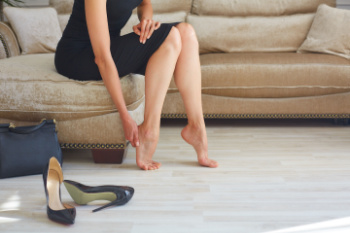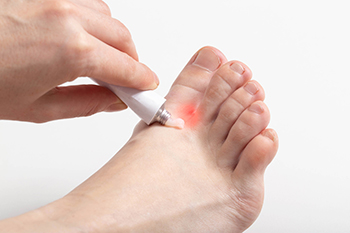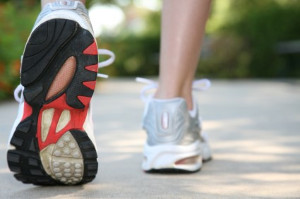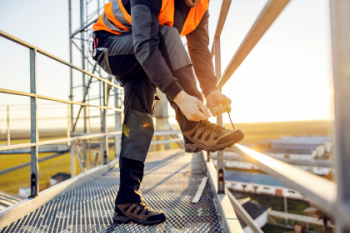Connect With Us
Blog
Items filtered by date: June 2024
High Heels and Women’s Foot Problems

High heels are a staple in many women's wardrobes, with about 40 percent wearing them daily. However, the fashionable choice often comes with a painful price. Three quarters of women wearing high heels experience foot pain regularly. The height of the heel and the narrowness of the toe box are the main culprits. High heels often force toes into unnatural positions, that may lead to bunions, which are bumps along the inside of the big toe, and hammertoes, where toes become bent at the middle joint. Over time, these conditions can worsen, causing significant discomfort and permanent changes in foot structure. High heels also can contribute to tight calf muscles, which may result in plantar fasciitis and Achilles tendonitis. To avoid these issues, select shoes with a proper fit, ensuring that your toes have adequate space to move. For those already suffering, treatments include toe pads, separators, and in severe cases, surgery. If you are experiencing foot pain from high heels, it may be time to reconsider your footwear choices. For guidance with foot problems, it is suggested that you schedule an appointment with a podiatrist for an exam and treatment options.
High heels have a history of causing foot and ankle problems. If you have any concerns about your feet or ankles, contact one of our podiatrists from Lexington Foot and Ankle Center, PSC. Our doctors can provide the care you need to keep you pain-free and on your feet.
Effects of High Heels on the Feet
High heels are popular shoes among women because of their many styles and societal appeal. Despite this, high heels can still cause many health problems if worn too frequently.
Which Parts of My Body Will Be Affected by High Heels?
- Ankle Joints
- Achilles Tendon – May shorten and stiffen with prolonged wear
- Balls of the Feet
- Knees – Heels cause the knees to bend constantly, creating stress on them
- Back – They decrease the spine’s ability to absorb shock, which may lead to back pain. The vertebrae of the lower back may compress.
What Kinds of Foot Problems Can Develop from Wearing High Heels?
- Corns
- Calluses
- Hammertoe
- Bunions
- Morton’s Neuroma
- Plantar Fasciitis
How Can I Still Wear High Heels and Maintain Foot Health?
If you want to wear high heeled shoes, make sure that you are not wearing them every day, as this will help prevent long term physical problems. Try wearing thicker heels as opposed to stilettos to distribute weight more evenly across the feet. Always make sure you are wearing the proper shoes for the right occasion, such as sneakers for exercising. If you walk to work, try carrying your heels with you and changing into them once you arrive at work. Adding inserts to your heels can help cushion your feet and absorb shock. Full foot inserts or metatarsal pads are available.
If you have any questions please feel free to contact our offices located in Harrodsburg, Frankfort, Georgetown, and Lexington, KY . We offer the newest diagnostic and treatment technologies for all your foot and ankle needs.
Athlete’s Foot Relief and Prevention Tips
 Athlete's foot, or tinea pedis, is a common fungal infection affecting the skin of the feet, typically occurring between the toes. There are three main types of athlete’s foot, which are interdigital, moccasin, and vesicular. Interdigital athlete's foot typically occurs between the toes and is characterized by itching, scaling, and sometimes maceration of the skin. Moccasin athlete's foot affects the soles and sides of the feet, presenting as dry, thickened, and scaly skin that can sometimes crack. Vesicular athlete's foot features fluid-filled blisters, often appearing on the instep, and can cause intense itching and discomfort. The infection is caused by dermatophytes, which are fungi that thrive in warm, moist environments like locker rooms, public showers, and swimming pools. Risk factors include wearing tight, non-breathable footwear, sweating heavily, and walking barefoot in damp communal areas. Symptoms include itching, burning, peeling, and cracked skin, often accompanied by redness and blisters. Athlete's foot is extremely contagious and can spread through direct contact with infected skin or contaminated surfaces. Treatment involves antifungal medications, available as creams, sprays, or oral prescriptions, depending on the severity. If you have athlete’s foot, it is strongly suggested that you visit a podiatrist who can effectively treat the infection, which often includes prescribed medication.
Athlete's foot, or tinea pedis, is a common fungal infection affecting the skin of the feet, typically occurring between the toes. There are three main types of athlete’s foot, which are interdigital, moccasin, and vesicular. Interdigital athlete's foot typically occurs between the toes and is characterized by itching, scaling, and sometimes maceration of the skin. Moccasin athlete's foot affects the soles and sides of the feet, presenting as dry, thickened, and scaly skin that can sometimes crack. Vesicular athlete's foot features fluid-filled blisters, often appearing on the instep, and can cause intense itching and discomfort. The infection is caused by dermatophytes, which are fungi that thrive in warm, moist environments like locker rooms, public showers, and swimming pools. Risk factors include wearing tight, non-breathable footwear, sweating heavily, and walking barefoot in damp communal areas. Symptoms include itching, burning, peeling, and cracked skin, often accompanied by redness and blisters. Athlete's foot is extremely contagious and can spread through direct contact with infected skin or contaminated surfaces. Treatment involves antifungal medications, available as creams, sprays, or oral prescriptions, depending on the severity. If you have athlete’s foot, it is strongly suggested that you visit a podiatrist who can effectively treat the infection, which often includes prescribed medication.
Athlete’s foot is an inconvenient condition that can be easily reduced with the proper treatment. If you have any concerns about your feet and ankles, contact one of our podiatrists from Lexington Foot and Ankle Center, PSC. Our doctors will treat your foot and ankle needs.
Athlete’s Foot: The Sole Story
Athlete's foot, also known as tinea pedis, can be an extremely contagious foot infection. It is commonly contracted in public changing areas and bathrooms, dormitory style living quarters, around locker rooms and public swimming pools, or anywhere your feet often come into contact with other people.
Solutions to Combat Athlete’s Foot
- Hydrate your feet by using lotion
- Exfoliate
- Buff off nails
- Use of anti-fungal products
- Examine your feet and visit your doctor if any suspicious blisters or cuts develop
Athlete’s foot can cause many irritating symptoms such as dry and flaking skin, itching, and redness. Some more severe symptoms can include bleeding and cracked skin, intense itching and burning, and even pain when walking. In the worst cases, Athlete’s foot can cause blistering as well. Speak to your podiatrist for a better understanding of the different causes of Athlete’s foot, as well as help in determining which treatment options are best for you.
If you have any questions please feel free to contact our offices located in Harrodsburg, Frankfort, Georgetown, and Lexington, KY . We offer the newest diagnostic and treatment technologies for all your foot and ankle needs.
Choosing the Right Running Shoes for Your Needs

When it comes to running, selecting the appropriate footwear is essential for comfort, performance, and injury prevention. For long-distance running, cushioned shoes with ample support are ideal to absorb shock and reduce fatigue, enhancing endurance. Trail running demands shoes with rugged outsoles and superior traction to navigate uneven terrain and provide stability on rocky paths. If you are into sprinting or track running, lightweight shoes with minimal cushioning and a snug fit promote agility and speed. Cross-training shoes offer versatility for various activities, blending features suitable for running, jumping, and lateral movements. For those with overpronation or flat feet, motion-control shoes with reinforced arch support help correct gait imbalances and prevent injuries. Conversely, neutral shoes suit runners with normal pronation, offering balanced cushioning and support. If you have developed pain from wearing the wrong type of running shoes, it is suggested that you visit a podiatrist who can treat any foot ailment, and educate you about what type of shoes to purchase for your running style.
If you are a runner, wearing the right running shoe is essential. For more information, contact one of our podiatrists from Lexington Foot and Ankle Center, PSC. Our doctors can provide the care you need to keep you pain-free and on your feet.
Choosing the Right Running Shoe for Your Foot Type
To increase performance and avoid the risk of injury, it is important to choose the right running shoe based on your foot type. The general design of running shoes revolves around pronation, which is how the ankle rolls from outside to inside when the foot strikes the ground.
- Neutral runners are able to choose from a wide variety of shoes, including minimalist shoes or even going barefoot.
- Runners who overpronate, or experience an over-abundance of ankle rolling, should choose shoes that provide extra motion control and stability.
- Runners who underpronate, or supinate, have feet that have high arches and lack flexibility, preventing shock absorption. They require shoes with more flexibility and cushion.
If you have any questions please feel free to contact our offices located in Harrodsburg, Frankfort, Georgetown, and Lexington, KY . We offer the newest diagnostic and treatment technologies for all your foot and ankle needs.
It's Time for Beautiful Feet
Foot Care Guidelines for Work

Maintaining foot health at work is essential for overall well-being and safety. Whether enduring long hours on your feet or navigating potential hazards, prioritizing proper foot care can prevent injuries and discomfort. Work-related foot injuries primarily stem from punctures, crushing, sprains, and falls, underscoring the importance of foot safety measures. Neglecting foot care not only heightens injury risks but also contributes to common issues like calluses, ingrown toenails, and fatigue, all of which impairs work performance. Identifying workplace hazards such as prolonged standing, unsuitable flooring and wearing ill-fitted footwear is important for injury prevention. Addressing these concerns through job and workplace design adjustments, including rotation, ergonomic flooring, and protective footwear is essential. Additionally, cultivating good foot care habits like daily washing, toenail trimming, and wearing appropriate socks and footwear is key. Incorporating exercises to alleviate strain during prolonged standing can help. Investing in foot care not only safeguards against injuries but also enhances productivity. If you spend long hours of your work day on your feet, it is suggested that you visit a podiatrist for related foot pain, injuries, or conditions.
While working on the feet, it is important to take the proper care of them. For more information about working on your feet, contact one of our podiatrists from Lexington Foot and Ankle Center, PSC. Our doctors will treat your foot and ankle needs.
Working on Your Feet
Standing on your feet for long periods of time can cause stress and pain in your feet. Your whole body may experience change in terms of posture, back pain, bunions, callouses and or plantar warts. There are ways to avoid these conditions with proper foot care, smart choices and correct posture.
Positive Changes
Negative heeled shoe – Choosing this shoe type places the heel slightly lower than the ball of the foot. These are great for overall foot health. Find shoes that fit you correctly.
Go barefoot – Our feet were not designed to be enclosed for all hours of the day. Try to periodically expose your feet to air.
Eliminate Pain
Foot Exercises – Performing simple exercises, incorporating yoga and doing stretches are beneficial. This will allow increased blood flow to the area and muscles of the foot.
Achilles tendon – Stretching the foot out flat on the floor will relax the calf muscles and tendon. These exercises can be performed almost anywhere. Make sure you add these exercises to your daily regimen.
With a little bit of this information and knowing more about foot health, you will notice changes. Foot stretches and proper footwear will help with pain and prevent further issues.
If you have any questions please feel free to contact our offices located in Harrodsburg, Frankfort, Georgetown, and Lexington, KY . We offer the newest diagnostic and treatment technologies for all your foot and ankle needs.
